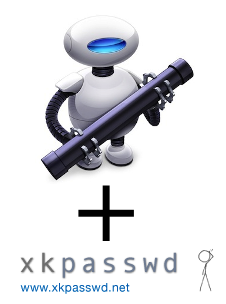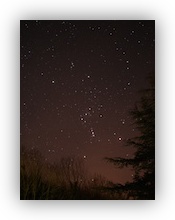Dec
22
Photographing the Heavens on a Budget
Filed Under Photography, Science & Astronomy on December 22, 2012 | 3 Comments
I recently gave a talk to Astro2, the Astronomy and Physics Society in NUI Maynooth. The talk focused on taking photos of the heavens without breaking the bank. If you set your expectations appropriately you can shoot the sky with literally any camera. You’ve not going turn your iPhone into the Hubble Space Telescope of course, but you can always get something nice, even if it’s “just” including the Moon and planets into your landscape shots.
The core idea is that you need to take as much control away from the camera’s computer as possible, so that you can push the device right up to it’s limits. To do that you need to understand how your camera works, so the talk starts with a primer on the theory of photography.
The talk is very heavily illustrated with example photos, and each example comes with a description of the settings used when shooting it.
I was asked in the talk to upload the slide deck, so I have (sorry it took so long).
Aug
4
Making an XKpasswd Automator Action
Filed Under My Projects, Software Development, Computers & Tech on August 4, 2012 | 2 Comments
 A few weeks ago on the Chit Chat Across the Pond segment of the Nosillacast, I mentioned that I had an OS X service set up to generate a random password using my XKpasswd Perl module and copy it to the clipboard. Listeners enquired as to how they would go about doing that, so as promised, here’s a quick tutorial.
A few weeks ago on the Chit Chat Across the Pond segment of the Nosillacast, I mentioned that I had an OS X service set up to generate a random password using my XKpasswd Perl module and copy it to the clipboard. Listeners enquired as to how they would go about doing that, so as promised, here’s a quick tutorial.
Obviously this tutorial is for Mac OS X users only, because OS-wide Services and Automator are OS X features. The screenshots are taken on 10.8 Mountain Lion, but this same technique definitely also works on OSX 10.7 Lion, and probably even on 10.6 Snow Leopard. This tutorial also assumes that you have downloaded the XKpasswd module, and saved it somewhere on your computer, along with either the sample dictionary file included with the module or one of your own making, and that you know where on your computer those files have been saved. In other words, you need to have XKpasswd.pm and a text file with one word per line somewhere on your hard drive. In my sample code I’m going to assume you’ve installed the Perl module to the suggested location, /usr/local/xkpasswd/XKpasswd.pm, and that you have customised the sample dictionary a little (more secure that way), and saved it to /usr/local/xkpasswd/dict.txt.
Jun
17
WebifyImages.pm – My Image Editing Scripts (v0.2)
Filed Under Photography, Software Development, Computers & Tech on June 17, 2012 | 6 Comments
Yesterday I posted my thoughts on watermarking images for uploading to the web. This post formed the basis of myself and Allison Sheridan’s discussions in the Chit Chat Across the Pond segment on tonight’s Nosillacast Mac Podcast. During the discussion we talked a little about how I watermark my images, and I realised that I hadn’t released a version of my image processing scripts since 2008! I promised I’d remedy that, so today, after a little tidying up, I’m releasing the current snapshot of my scripts under the FreeBSD license.
I’m not releasing these scripts as a polished software package that’s ready to use, but rather, as a starting point for anyone who wants to create their own watermarking scripts. If you’re not prepared to get stuck into the command line and a little Perl (VERY little is needed mind), these scripts are of no use to you!
The scripts rely on the free and open source ImageMagick command line image editing tools, so you’ll need to install ImageMagick before you get stuck in. If you’re running OS X, I’d recommend installing ImageMagick via the free and open source MacPorts package manager.
Jan
29
Tips for Photographing Stars With Basic Equipment
Filed Under Science & Astronomy, Photography on January 29, 2012 | 9 Comments
 Hard-core astrophotography is very difficult, and requires quite a lot of quite expensive equipment, but, you can do surprisingly much with surprisingly little if you don’t set your expectations unrealistically high. The big problem with the night sky is that it moves. Well, strictly speaking it’s the earth that’s moving rather than the sky, but the point is, stars don’t appear to stand still. Normally when you have a subject that’s dim, you use a tripod and just leave the shutter open for as long as it takes, but since everything astronomical is always on the move, that doesn’t work! The way the pros get around this is with expensive mounts that track the movements of the heavens, opening up the possibility of long exposures. With that problem over-come the pros then run into a whole new set of problems with how noise builds up in sensors over long exposures, so they end up needing some quite advanced techniques and a lot of software and skill as well as the fancy hardware.
Hard-core astrophotography is very difficult, and requires quite a lot of quite expensive equipment, but, you can do surprisingly much with surprisingly little if you don’t set your expectations unrealistically high. The big problem with the night sky is that it moves. Well, strictly speaking it’s the earth that’s moving rather than the sky, but the point is, stars don’t appear to stand still. Normally when you have a subject that’s dim, you use a tripod and just leave the shutter open for as long as it takes, but since everything astronomical is always on the move, that doesn’t work! The way the pros get around this is with expensive mounts that track the movements of the heavens, opening up the possibility of long exposures. With that problem over-come the pros then run into a whole new set of problems with how noise builds up in sensors over long exposures, so they end up needing some quite advanced techniques and a lot of software and skill as well as the fancy hardware.
I don’t have any of the fancy gear, nor any of the fancy software, nor indeed, the skills needed to get good results out of the equipment I don’t have! But, I can still get a descent shot of a star field, and all I need is three things:
- A camera that will allow manual control of the aperture, shutter speed, ISO and white balance, exposure times of up to 30 seconds, and manual focusing or some form of focus lock
- a tripod
- A remote shutter release (or, as a work-around, a delayed shutter release mode)
I did also mention that you need realistic expectations, basically, what we’re aiming for here is shots of large sections of the sky. Think a nice shot of a constellation. If you have visions of detailed views of spiral galaxies in your head – get them out now – that’s for the pros with their fancy kit!
Jul
1
Getting ClamXav to use a Proxy Server
Filed Under System Administration, Security, Computers & Tech on July 1, 2011 | 4 Comments
I’ve been looking at different free Mac AV solutions so that I can make recommendations to less-computer-savy family members, and this afernoon I decided to give ClamXav a go. I’d tried it a few years ago and wasn’t very happy, but I’d been told by friends that it has improved a lot since, and a first glance at the GUI suggests they’re right. Unfortunately I didn’t get very far with my initial testing this afternoon because I’m in an environment where I have to use an HTTP proxy server to access the net, and ClamXav appears not to support proxies at first glance. It ignores OS X’s system-wide proxy settings, and it has no interface elements of its own to allow you to specify a proxy server manually. This implies that ClamXav doesn’t support proxies, but it actually does, they just didn’t bother to expose that functionality through the GUI.
ClamXav is just a GUI wrapper for the free and open source Clam AntiVirus toolkit, and it uses Clam’s regular auto-updating tool freshclam. Although the ClamXav GUI doesn’t give you control over the variables in the freshclam configuration file, that file does exist as part of ClamXav (/usr/local/clamXav/etc/freshclam.conf), and if you edit it manually it will respect the settings specified in that file. If you’re not afraid of the Terminal, you can easily edit this configuration file manually to get ClamXav to use a proxy server for updates.
Mar
2
Automator Workflow for Stripping Keywords from Images
Filed Under My Projects, Photography, Software Development, Computers & Tech on March 2, 2011 | 5 Comments
Following on from my post yesterday with three examples of using Automator to create Services, and some good suggestions in the comments, I spent some time this afternoon making the script in the third of those examples a little more efficient, and a lot more robust.
The Service I optimised was the one to strip keywords from image files. This Service assumes that both Growl and EXIFTool are installed, and that you’re running OS X 10.6 Snow Leopard or later.
Mar
2
Automator + Services = Image Editing Automation Heaven
Filed Under Software Development, Computers & Tech on | 6 Comments
![]() Some Apple haters just love to say that there is nothing to a Mac except for flashy marketing. There are a million different reasons that’s BS, but one in particular is ease of automation. The learning curve to start automating your Mac is very short and very gentle. Without ever seeing a single line of code you can add your own custom functionality to OS X to relieve you of your most boring repetitive tasks. If you can tolerate seeing a line or two of code, you can take things even further and tie Unix command line tools straight into your GUI. The best candidates for automation are simple repetitive tasks that you do often. You might only save 30 seconds each time, but if do that 10 times a day that soon adds up! In this post I just want to give three simple examples to whet your appetite and hopefully get you thinking about some simple tasks in your computing life that you could easily automate.
Some Apple haters just love to say that there is nothing to a Mac except for flashy marketing. There are a million different reasons that’s BS, but one in particular is ease of automation. The learning curve to start automating your Mac is very short and very gentle. Without ever seeing a single line of code you can add your own custom functionality to OS X to relieve you of your most boring repetitive tasks. If you can tolerate seeing a line or two of code, you can take things even further and tie Unix command line tools straight into your GUI. The best candidates for automation are simple repetitive tasks that you do often. You might only save 30 seconds each time, but if do that 10 times a day that soon adds up! In this post I just want to give three simple examples to whet your appetite and hopefully get you thinking about some simple tasks in your computing life that you could easily automate.
Jul
31
Some Thoughts on Composition
Filed Under Photography on July 31, 2010 | 8 Comments
Initially I’d started writing these thoughts up as bullet points to use as show-notes for this weekend’s Chit Chat Across the Pond segment on the NosillaCast, but as I worked on them I realised they were worth developing into a full blog post. The aim here is to share some of my thoughts on composing photos. A lot of people think that the difference between a snapshot and a professional looking photo is the camera, which is true to some extent, but a much more important factor is the composition. I believe that the single most important thing you can do to improve your photography is to work on your composition. Thankfully, a little effort goes a long way, so it’s time very well spent.
May
1
Getting from Auto to Manual
Filed Under Photography on May 1, 2010 | 4 Comments
I was preparing notes for recording a Chit Chat Across the Pond segment on this topic with Allison this evening, and it occurred to me that this would make a good blog post, so I stopped making bullet points and wrote this article instead.
I still remember very vividly the first time I held my first DSLR. I was shocked by how many knobs and buttons there were, and I was very intimidated by all that apparent complexity. The appeal of the “auto” setting was very strong, and for weeks that’s where my camera stayed. The thing is, using a DSLR on full auto is such a waste, why get a camera that gives you so much artistic control, just to surrender it all to the camera’s primitive intelligence?
Today my DSLR is never in Auto, it spends a lot of time in ‘A’ mode (‘Aperture Priority’, TOTALLY different to Auto), and quite a bit in ‘M’ mode (full manual). Being the master of your camera in full manual mode is very liberating, and opens up a lot of creative possibilities. So, how do you get from Auto to Manual?
Jan
16
Why I Love Automater & Services in OS X 10.6 SnowLeopard
Filed Under Software Development, Computers & Tech on January 16, 2010 | 5 Comments
Since I first started using OS X at version 10.3 I’ve always felt that the services menu had great potential but badly needed some fit and polish to make it actually live up to that promise. It has been so bad that it is basically forgotten, and almost no one remebers that it even exists. In every application in OS X there is a menu item under the apps’s main menu (the one in bold with the same name as the app) called Services, that’s what I’m talking about. When it comes to the services menu both Tiger and Leopard were major disappointments because they didn’t bring any real improvement to the neglected services menu. SnowLeopard on the other hand is a totally different story. Similarly, when Automator first came out I thought it had great promise, but that it was a very 1.0 kind of offering, again, in need of some fit and polish to allow it live up to its obvious potential. SnowLeopard provides a lot of that fit and polish, and really brings Automator forward significantly. And what’s better, Apple have combined the fit and finish in these two apparently unrelated products together, to provide some exceptionally powerful functionality.







